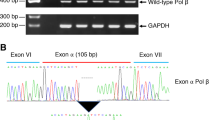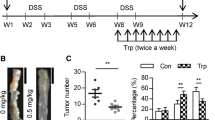Abstract
DNA polymerase (POL) λ plays an important role during DNA repair and DNA nonhomologous recombination processes. A novel POL λ variant was cloned from a human liver cDNA library and named POL λ2 (GenBank Accession No. AY302442). POL λ2 has 2206 base pairs in length with an open reading frame of 1452 base pairs encoding a 482-amino-acids protein. Bioinformatics analysis reveals that POL λ2 spans 7.9 kb on human chromosome 10q24 and is composed of 8 exons and 7 introns. It has the specific domain of DNA polymerase X family-POL Xc at the C-terminus and BRCT domain at the N-terminus. POL λ2 was localized predominantly in nucleus in transfected L0–2 cells. It was expressed abundantly in liver and testis, weakly in ovary, and undetectably in other tested human tissues. In comparison with the expression ratio between POL λ and POL λ2 in normal liver tissues and hepatocellular carcinoma (HCC) adjacent tissues, the ratio was aberrant in 80% of those 15 HCC specimens examined due to the up-regulated expression of POL λ. This abnormality might be involved in hepatocarcinogenesis. The recombinant POL λ2 with His-tag was expressed as a soluble active protein in E. coli BL21 (DE3)CONDON Plus and purified by Ni-NTA resin and then desalted by Superdex-75 chromatography in an FPLC system. The analysis using isotope a-32P-dCTP incorporation in vitro showed that the purified recombinant POL λ2 exhibited DNA polymerase activity.
Similar content being viewed by others
References
Hübscher U, Maga G, Spadari S. Eukaryotic DNA polymerases. Annu Rev Biochem, 2002, 71: 133–163
Aoufouchi S, Flatter E, Dahan A, et al. Two novel human and mouse DNA polymerases of the polX family. Nucleic Acids Res, 2000, 28: 3684–3693
Garcia-Diaz M, Dominguez O, Lopez-Fernandez L A, et al. DNA polymerase lambda (Pol lambda), a novel eukaryotic DNA polymerase with a potential role in meiosis. J Mol Biol, 2000, 301: 851–867
Nagasawa K, Kitamura K, Yasui A, et al. Identification and characterization of human DNA polymerase beta 2, A DNA polymerase beta-related enzyme. J Biol Chem, 2000, 275: 31233–31238
Bork P, Hofmann K, Bucher P, et al. A superfamily of conserved domains in DNA damage-responsive cell cycle checkpoint proteins. FASEB J, 1997, 11: 68–76
Doherty A J, Serpell L C, Ponting C P. The helix-hairpin-helix DNA-binding motif: A structural basis for non-sequence-specific recognition of DNA. Nucleic Acids Res, 1996, 24: 2488–2497
Ramadan K, Shevelev I, Hübsche U. The DNA-polymerase-X family: Controllers of DNA quality? Nat Rev Mol Cell Biol, 2004, 5: 1038–1043
Lee J W, Blanco L, Zhou T, et al. Implication of DNA polymerase lambda in alignment-based gap filling for nonhomologous DNA end joining in human nuclear extracts. J Biol Chem, 2004, 279: 805–811
Ramadan K, Maga G, Shevelev I V, et al. Human DNA polymerase lambda possesses terminal deoxyribonucleotidyl transferase activity and can elongate RNA primers: Implications for novel functions. J Mol Biol, 2003, 328: 63–72
Kedar P S, Kim S J, Robertson A, et al. Direct interaction between mammalian DNA polymerase beta and proliferating cell nuclear antigen. J Biol Chem, 2002, 277: 31115–31123
Bebenek K, Garcia-Diaz M, Blanco L, et al. The frameshift infidelity of human DNA polymerase lambda. Implications for function. J Biol Chem, 2003, 278: 34685–34690
Maga G, Sheveley I, Villani G, et al. Human replication protein A can suppress the intrinsic in vitro mutator phenotype of human DNA polymerase lambda. Nucleic Acids Res, 2006, 34: 1405–1415
Shimazaki N, Yoshida K, Kobayashi T, et al. Over-expression of human DNA polymerase lambda in E. coli and characterization of the recombinant enzyme. Genes Cells, 2002, 7: 639–651
Mizushina Y, Kamisuki S, Kasai N, et al. Petasiphenol: A DNA polymerase lambda inhibitor. Biochemistry, 2002, 41: 14463–14471
Author information
Authors and Affiliations
Corresponding author
Additional information
Supported by the National Natural Science Foundation of China (Grant No. 30370752), Shanghai Key Technologies R&D Program of Biomedicine (Grant No. 05dz19302) and CNHLPP (Grant No. 2004BA711A19)
Recommended by Prof. SHEN Yan, member of the editorial board of Science in China
Rights and permissions
About this article
Cite this article
Gu, F., You, C., Liu, J. et al. Cloning, expression and characterization of human tissue-specific DNA polymerase λ2. SCI CHINA SER C 50, 457–465 (2007). https://doi.org/10.1007/s11427-007-0059-4
Received:
Accepted:
Issue Date:
DOI: https://doi.org/10.1007/s11427-007-0059-4




